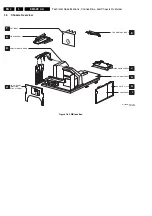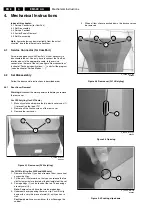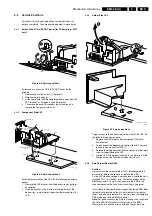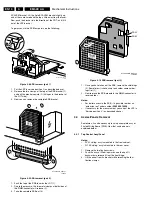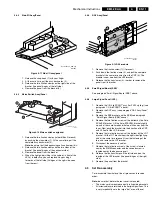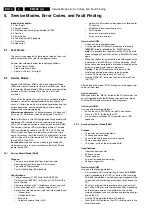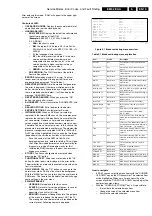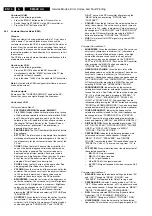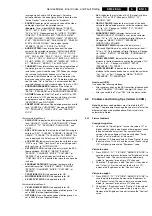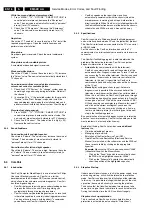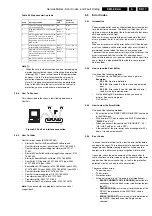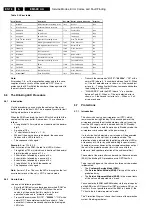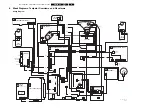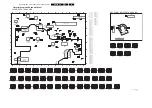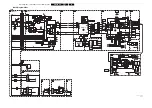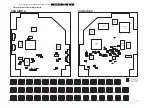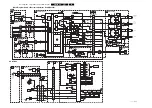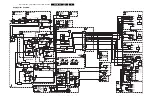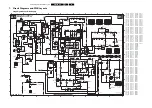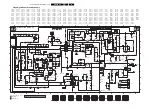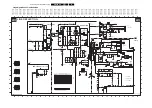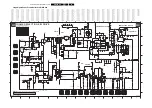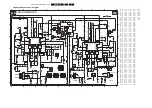
Service Modes, Error Codes, and Fault Finding
EN 20
EM5.2E AA
5.
Take care not to touch the "hot" heatsink while disconnecting
the SSB, despite the fact that the mains cord is out of the mains
socket. There can still be an annoying rest-voltage on the
heatsink for a short while. This, because the discharge
resistors 3502 and 3503 (on the LSP between hot and cold
part) are not stuffed for Europe. Instead, discharge resistors
3066 and 3057 on the Mains Switch panel are used, but
because they are located before the Mains switch, they only
discharge when this switch is "on".
Advice:
when you remove the SSB, disconnect the Mains
cord, but keep the Mains Switch "on".
Do not try to measure on the SSB side, which is facing the 'hot'
heatsink. This is dangerous. Most service test points are
guided to the 'tuner' side and are indicated by the 'service'
printing.
Where the circuitry was too "crowded" for service printing, you
can find the correct location on the "test point overviews" in this
manual.
A very large part of the LSP is "
hot
", such as:
•
The primary part of the Standby Supply.
•
The whole Main supply (except for the secondary Audio
supply).
•
And the complete deflection circuitry (so notice that the
deflection coil is hot!).
5.8.2
Start-up Sequence
Figure 5-4 Start-up circuitry
The start up sequence differs from other sets (e.g. MG-sets or
EM2E-sets, but is same as in EM3E-set):
1.
When the set is switched "on", the 5 and 8 V lines
("+5V_CON" and "+8V_CON") of the standby power
supply are activated.
2.
After the OTC senses them, the P will address the HOP via
the I
2
C
-bus, to start the drive [1].
3.
Via the "SUP-ENABLE" signal, the Main Supply is switched
"on" and will deliver the V_BAT to the Line deflection stage
[2].
4.
EHT generation is now started.
5.
The OTC will un-blank the picture.
6.
When you switch "off" the set, this is done in a controlled
way via the POR signal [3].
Note:
Standby is not directly achieved via the Standby line of
the microprocessor, but indirectly via the HOP circuitry.
5.8.3
ComPair
This chassis does not have an IR transmitting LED (as in MG-
sets). Therefore, a "Service" (ComPair) connector is
implemented at the rear side of the set, which is directly
accessible (as in A10-, EM2E-, EM3E and EM5E-sets). In
addition to this, there is also a blinking LED procedure to show
the contents of the error buffer.
When you use ComPair, you have the possibility to activate a
"stepwise start-up" mode. With this mode, you can initiate the
start-up sequence step by step. This also means that in certain
steps, some protections are not activated. This is sometimes
very convenient during repair.
5.8.4
Protections
Activating SDM via the "service pads" will overrule the
processor-controlled protections, but not the hardware
protections. This means, that the A/D-input protections (5 and
8 V) and the I
2
C
"not-acknowledging" info of the feature box
(FBX) and of the Tuner are overruled.
Caution:
When doing this, the service technician must know
what he is doing, as it could lead to damaging the set.
The "ARC"- and/or "BRIDGECOIL" protection are hardly ever
triggered, however:
•
When you suspect the "ARC" protection, look for bad
solder joints and smell. By interrupting resistor 3497, this
protection is disabled (special attention needed!).
•
When you suspect the "BRIDGECOIL" protection, which
can also be due to a too wide picture amplitude, shorten G
and S of the E/W MOSFET 7480. This will disable the
protection. You will now have minimal horizontal amplitude.
Re-align the horizontal amplitude in the SAM menu and
remove the G/S short of TS7480.
5.8.5
Main Supply
The simplest way is, to replace the components of the Main
Supply with repair kit 3122 785 90310.
More detailed way:
1.
Replace FET 7504 and zener 6505.
2.
Remove the SSB panel.
3.
Short B and E of TS7529, in order to put the Main Supply
in "on"-mode (TS7529 is blocking then).
Caution:
To prevent that R3403 and TS7443 will be
damaged,
first disable the HW-protection of the
deflection circuit.
Therefore short circuit C2642 on the
LSP (diagram A4).
4.
Attach a load of 500 O to V_BAT capacitor C2515 (the
supply can not work without a minimum load).
5.
Use a variac, and slowly increase the V_MAINS. Measure
over sensing resistors R3514//15, if a nice sawtooth
voltage becomes available.
6.
Also measure the V_BAT. This may never 141 V.
If it does, there is something wrong in the feedback circuitry
(e.g. regulator 7506).
Note:
Be careful when measuring on the gate of FET TS7504.
This circuitry is very high ohmic and can easily be damaged
(first connect ground to measuring equipment, than measure
the gate).
5.8.6
Standby Supply
The simplest way is to replace the components of the Standby
Supply with repair kit 3122 785 90460.
RESET
5VCON
8VCON
8V
29
I2C BUS
5
17/39
OUT
HOP
CUTOFF
(from
CRT panel)
START/STOP
START/STOP
COLD
EHT-INFO
HOT
7131
7141
5V
8V
+11D
OTC
POR
POR
7445
106
105
99
104
STANDBY
low 7131/41 closed
high 7131/41 open
220 VAC
STBY
SUPPLY
Vbat
SUP-ENABLE
MAIN
SUPPLY
PROT-
SENSING
LINE DEFL.
(BRIDGECOIL
-PROT)
(ARC-PROT)
FRAME
DEFL
(NON-VFB)
CL16532044_023.eps
140501
1
3
2

